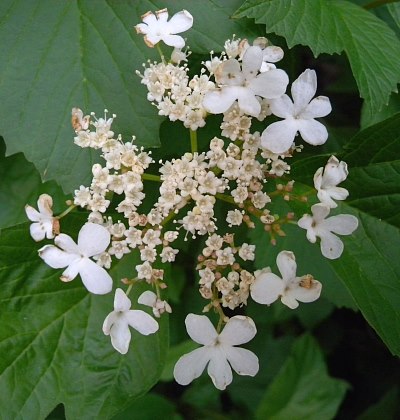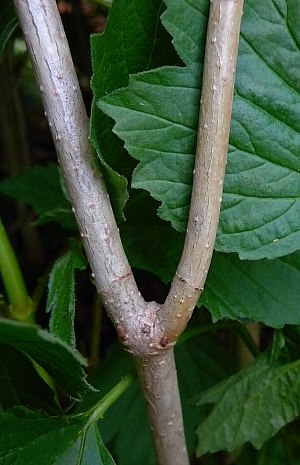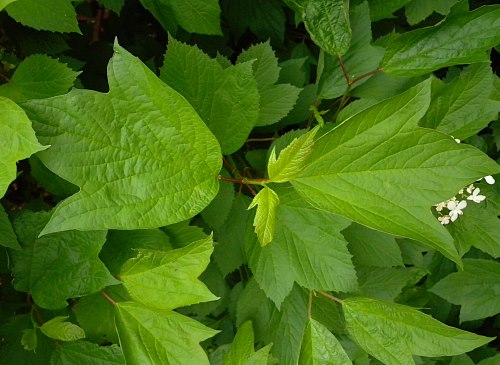
Some of the upper and outer shoots terminate in flat-headed panicles (cymes) of white flowers. Individual panicles span about 2-4" across; their branches are light green to red and glabrous. Along the outer margin of each panicle, there are several sterile flowers about ¾" across. Each sterile flower has 5 white spreading petals and a short tubular calyx that is 5-toothed and green. Within the interior of each panicle, there are many fertile flowers about ¼" across. Each fertile flower has 5 white spreading petals, a short tubular calyx that is 5-toothed and green, 5 stamens, and a pistil. The blooming period occurs during late spring to early summer and lasts about 3-4 weeks. The floral scent is unpleasant. The fertile flowers are replaced by one-seeded drupes that are about 1/3" (8 mm.) across. They become bright red at maturity during late summer or early fall. Individual seeds are about 5 mm. across, nearly orbicular in shape, and flattened. The flesh of the drupes is tart. The root system is woody and branching. During autumn, the deciduous leaves become bright red.
Cultivation: The preference is full sun to light shade, wet to moist conditions, and a boreal climate with cool to moderately warm summers. The soil should contain decaying organic matter to retain moisture.

Range & Habitat: The native American Cranberry Bush is a rare shrub that is found in widely scattered areas in the upper half of Illinois (see Distribution Map). Habitats consist of cool moist woodlands, streambanks in wooded areas, sandy swamps, soggy thickets, edges of sandy marshes, forested bogs, and roadside ditches. American Cranberry Bush is occasionally cultivated as an ornamental landscape plant. Outside of cultivation, this shrub is usually found in high quality wetlands where the native flora is still intact.
Faunal Associations: The nectar of pollen of the flowers attract Halictid bees (Lasioglossum spp.), Andrenid bees (Andrena spp.), flower flies (Syrphidae), Tachinid flies, seed maggot flies (Delia spp.), long-horned beetles (Cerambycidae), skin beetles (Dermestidae), tumbling flower beetles (Mordellidae), and plant bugs. Ants also feed on the nectar that is exuded from the extra-floral nectaries on the leaf petioles (Krannitz & Maun, 1991; Wilhelm & Rericha, 2017; Lisberg & Young, 2003; Krombein et al., 1979). Other insects feed destructively on the foliage, sap, and other parts of American Cranberry Bush and European Cranberry Bush (Viburnum trilobum, Viburnum opulus). These insects include the Black Bean Aphid (Aphis fabae), Viburnum Aphid (Aphis viburniphila), Snowball Aphid (Neoceruraphis viburnicola), another aphid (Aphis viburni), Viburnum Leaf Beetle (Pyrrhalta viburni), larvae of the moth, Rose Hooktips (Oreta rosea), and later instars of the butterfly, Baltimore (Euphydryas phaeton); see Wilhelm & Rericha (2017), Pepper (1965), Marshall (2006), and Blackman & Eastop (accessed 2013). A few birds have been observed to feed on the red fruits of these shrubs, particularly during the winter when other sources of food are scarce; this includes the Cedar Waxwing, Northern Cardinal, Eastern Bluebird, Ruffed Grouse, Wild Turkey, and Ring-necked Pheasant (DeGraaf, 2002; Bennetts, 1900). These fruits are also a minor source of food for the American Black Bear (Noyce & Coy, 1990; Mosnier et al., 2008).
Photographic Location: Along a building of the Illinois Natural History Survey in Champaign, Illinois..
Comments: American Cranberry Bush has attractive flowers, foliage, drupes, and autumn coloration. Because birds consume the drupes sparingly, they often persist during the winter. The edible drupes have a tart flavor that is similar to cranberries. However, it is best to use them before a hard frost occurs, which can degrade their flavor. American Cranberry Bush is very similar to fertile cultivars of European Cranberry Bush (Viburnum opulus), and it is sometimes regarded as a variety of this latter shrub (Viburnum opulus americanum).

The European Cranberry Bush occasionally escapes from cultivation. It prefers habitats that are similar to those of American Cranberry Bush and it is potentially invasive. These two shrubs differ from each other as follows: 1) American Cranberry Bush has petiolar glands with convex upper surfaces, while the petiolar glands of European Cranberry Bush have concave upper surfaces; 2) the stipules of American Cranberry Bush are simple and deciduous, while the stipules of European Cranberry Bush are bristly and more persistent; 3) the leaves of American Cranberry Bush have fewer teeth (or no teeth) along their margins than the leaves of European Cranberry Bush; and 4) the drupes of American Cranberry Bush are reportedly less sour and bitter than those of European Cranberry Bush.